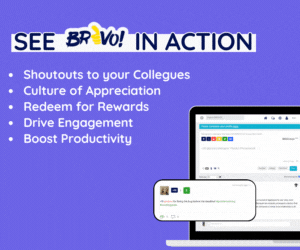
If you’ve ever felt underappreciated at work, you understand the value of employee recognition in the workplace.
Only one out of every three workers received praise or acknowledgment in the previous week, according to a Gallup survey. It is such a characteristic that has a direct impact on turnover and employee engagement. Employees who don’t feel appreciated are twice as likely to leave in the next year.
Small businesses may believe they cannot afford good employee appreciation. However, it is possible to make your workforce feel appreciated with or little to no cost.
People aren’t motivated by money only. Small honest expressions of gratitude can be just as effective as a bonus.
Below are the 9 helpful tips for doing employee recognition:
1- Be Specific And Accurate

It’s vital to be precise, personable, and correct. Nothing could be more unhelpful than getting the facts wrong and praising someone for their broad efforts while overlooking specific achievements.
Use complimentary language and communicate with the individual to demonstrate that you appreciate what they have accomplished and how difficult the work was.
When you can recognize someone based on their passions, the recognition becomes more meaningful. The most crucial part of a great recognition culture is verbal communication, but it’s also necessary to document the acknowledgment in a note, letter, corporate newsletter, or personnel file.
2- Make it Possible for Each Employee to Contribute

Because of the nature of their occupations or lower expectations for particular sorts of work, some employees do not have the opportunity to flourish.
Employees who perform well in their occupations – even low-level jobs– should be able to gain opportunities for increased responsibilities, job progression training, and cross-training in other corporate operations.
A dishwasher or janitor in the foodservice industry, for example, might be hired to help with food prep or learn how to operate one of the line’s stations.
Low-level personnel who do their jobs methodically may be asked to join trade associations, special projects, or civic and philanthropic teams that represent the company in more professional contexts.
3- Enlist Supervisors To Recognize Excellence

Instead of rewarding their employees for good work, too many supervisors focus on quality control by emphasizing problems and addressing work habits.
One of the most significant incentives for working harder is receiving a pat on the back from a direct boss. Your employees want to know that they did a good job, but outsiders may not know what defines a good job.
As a result, receiving praise from a superior is the highest form of appreciation. Supervisors can see when a job is well done, and strong leaders make their employees feel valued and significant.
Moreover, the most essential aspect is verbal acknowledgment, but it can be supplemented by a gift, a monetary incentive, or a promotion to a position with more responsibility if it is appropriate.
4- Make Use of Financial Incentives to Motivate Employees

Although monetary incentives aren’t always the most effective motivators, they can surely show appreciation for a job well done.
The awards can be for anything from revenue-generating activity to honoring people who provide the best customer service.
Increased commission rates, monetary prizes for quality work and meeting sales targets, rewards for punctuality and attendance, and bonuses for innovative work ideas that streamline business processes are all possible financial incentives.
5- Increase Recognition by Using Various Communication Channels

The most efficient way to recognize employees is through verbal communication, and receiving praise from an immediate supervisor is the most impactful kind of recognition.
Having said that, some people will always believe that talk is cheap.
The best technique is to publicize employee accomplishments in many forums, such as corporate newsletters, team meetings, company whiteboards, and other media, in addition to verbal praise.
If the achievement is newsworthy, consider sending a press release to the local newspaper or an industry trade publication.
6- Provide Your Employees With Bonuses and Holiday Rewards

Many businesses utilize performance-based systems to reward their employees in the run-up to the holidays.
Offering a standard bonus or gift package and rewarding workers for exceptional achievement with special awards, extra cash incentives, and Christmas gifts are the best practices for awarding holiday bonuses.
7- Make Sure to Recognize People’s Interests And Community Achievements

Strong human resource management increasingly focuses on employees holistically in an interactive and supportive atmosphere.
Employees enjoy being recognized for their extracurricular activities, hobbies, and passions because it keeps them from feeling like just cogs in the corporate machine.
Passions can also serve as rewards in and of themselves. Many corporations allow their employees to devote 20% or more of their time to personal projects such as community service or fundraising for national and international philanthropic organizations.
8- Make Use of Technology and Social Media to Spread News About Your Achievements

In today’s world of immediate communications, people don’t live in a vacuum, so it’s critical to share major successes and even human interest stories on the company’s social media platforms.
Customers and stakeholders can learn more about the subject by visiting the company’s website or Facebook page, which can be reinforced through tweets and SMS messages.
9- Create an Eye-catching Office Trophy Using a Gamification Strategy.

A spinning trophy or plaque may generate a lot of excitement for a small price. Of course, the more stunning the award, the more likely friendly competition will be.
Professional wrestlers and martial arts fans, for example, compete for championship “belts” in basic ways. Trophies aren’t always necessary.
Gamification tactics can be utilized in a variety of ways to drive and reward your employees to achieve greater levels of performance. Games and incentives help to establish a workplace culture that recognizes and rewards exceptional performance while also encouraging teamwork and the achievement of company goals.
Conclusion
Employee recognition can help any business grow faster in a better way. Any organization can make use of employee recognition to boom in its respective department.
There are various tips for doing employee recognition like being specific and accurate in your approach, giving incentives, providing employees with bonuses and holiday rewards.
You can make use of these tips to boom in your business.
To get the best of Employee recognition and to attain some bright ideas, log onto Getbravo






